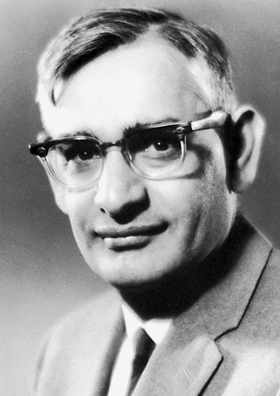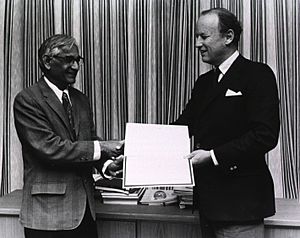Har Gobind Khorana facts for kids
Quick facts for kids
Har Gobind Khorana
|
|
|---|---|
 |
|
| Born | 9 January 1922 |
| Died | 9 November 2011 (aged 89) Concord, Massachusetts, U.S.
|
| Citizenship | United States |
| Alma mater |
|
| Known for | First to demonstrate the role of nucleotides in protein synthesis |
| Spouse(s) | Esther Elizabeth Sibler |
| Awards |
|
| Scientific career | |
| Fields | Molecular biology |
| Institutions |
|
| Doctoral advisor | Roger J.S. Beer |
| Doctoral students | Shiladitya DasSarma |
| Signature | |
 |
|
Har Gobind Khorana (born January 9, 1922 – died November 9, 2011) was a brilliant scientist who studied living things at a tiny level. He was an Indian American biochemist.
He won the 1968 Nobel Prize in Medicine with two other scientists, Marshall W. Nirenberg and Robert W. Holley. They won for their amazing research on nucleic acids. These are like blueprints inside our cells that carry the genetic code. They control how cells make proteins, which are vital for life.
Khorana was born in British India. He later moved to North America and taught at three different universities. In 1966, he became a citizen of the United States. He also received the National Medal of Science in 1987, which is a very high honor for scientists.
About Har Gobind Khorana's Life
Har Gobind Khorana was born in a small village called Raipur in British India. His parents were Ganpat Rai Khorana and Krishna Devi. He was the youngest of five children in a Punjabi Hindu family.
The exact date of his birth is not fully known. However, he believed it was January 9, 1922, and this date is now widely accepted.
Early Education and Family
Khorana's father worked as a village clerk for the British Indian government. Even though his family was poor, his father was determined to educate his children. Khorana once wrote that his family was "practically the only literate family in the village."
For his first four years of school, he learned under a tree! This was the only school in his small village. He didn't even own a pencil until he was six years old.
University Studies
Khorana went to D.A.V. High School in Multan. Later, he studied at the Punjab University in Lahore. He was able to attend thanks to scholarships. He earned his bachelor's degree in 1943 and his master's degree in 1945.
In 1945, Khorana moved to England to study organic chemistry at the University of Liverpool. He received a special fellowship from the Government of India. He earned his PhD in 1948, with Roger J. S. Beer as his advisor.
The next year, he continued his studies in Switzerland with Professor Vladimir Prelog. He worked for almost a year on a type of chemistry called alkaloid chemistry.
Moving to North America
After a short time in 1949, Khorana couldn't find a job in his home area. So, he went back to England. From 1950 to 1952, he worked at University of Cambridge on peptides and nucleotides.
In 1952, he moved to Vancouver, British Columbia, Canada, with his family. He took a job at the British Columbia Research Council at the University of British Columbia. He was excited to start his own lab there. Even though the facilities were simple, he had a lot of freedom to do his research.
Work in the United States
In 1960, Khorana moved to the United States. He became a co-director at the University of Wisconsin–Madison's Institute for Enzyme Research. He became a professor of biochemistry in 1962.
At Wisconsin, he helped figure out how RNA (ribonucleic acid) helps make proteins. He also started working on how to create working genes. It was during his time here that he completed the research that led to his Nobel Prize. The Nobel website says he "made important contributions to this field by building different RNA chains."
He became a US citizen in 1966. In 1970, Khorana joined the MIT as a professor. He retired from MIT in 2007.
Family Life
Har Gobind Khorana married Esther Elizabeth Sibler in 1952. They had met in Switzerland. They had three children: Julia Elizabeth, Emily Anne, and Dave Roy.
Groundbreaking Research
Khorana's Nobel Prize-winning work was about understanding the genetic code. This code tells our cells how to build proteins.
Understanding the Genetic Code
Scientists knew that DNA and RNA carried genetic information. But they didn't know exactly how the order of nucleotides (the building blocks of DNA and RNA) translated into the order of amino acids (the building blocks of proteins).
Khorana created artificial RNA molecules with repeating patterns. For example, an RNA with a repeating pattern of UCUCUCU would produce two alternating amino acids. This helped show that specific groups of three nucleotides, called "codons," code for specific amino acids.
He also discovered "stop codons." These are like punctuation marks in the genetic code that tell the cell when to stop making a protein.
Creating the First Synthetic Gene
Khorana was the first scientist to chemically create oligonucleotides. These are short, artificial pieces of DNA or RNA.
In 1972, after many years of work, he achieved something amazing: he created the world's first complete, working artificial gene outside of a living organism. He did this by linking together his custom-designed DNA pieces using special enzymes.
This invention was a huge step forward! Today, scientists use similar methods to create artificial genes for many purposes. They use them to study diseases, engineer new plants, and understand human evolution. You can even order a custom-made gene from companies now!
Later Research
After the mid-1970s, Khorana's lab studied a protein called bacteriorhodopsin. This protein is found in some bacteria and helps them convert light energy into chemical energy. Later, his lab also studied rhodopsin, a similar protein found in our eyes that helps us see.
A former colleague described Khorana as a "founding father" of chemical biology. He used his knowledge of chemistry to help unlock the secrets of the genetic code.
Awards and Honors
Besides sharing the Nobel Prize, Khorana received many other important awards and honors:
- He became a member of the United States National Academy of Sciences in 1966.
- He was elected to the American Academy of Arts and Sciences in 1967.
- He became a member of the American Philosophical Society in 1973.
- He was made a Foreign Member of the Royal Society in 1978.
The Khorana Program
In 2007, the University of Wisconsin–Madison, the Government of India, and the Indo-US Science and Technology Forum created the Khorana Program. This program aims to connect scientists, business people, and social leaders in the United States and India.
The program has three main goals:
- To give university students valuable research experience.
- To help with rural development and food security.
- To encourage partnerships between public and private groups in the U.S. and India.
The Khorana Program also works with the S.N. Bose Programs. These programs help students from India and America do research in science, technology, engineering, and math (STEM) fields.
In 2009, Khorana was honored at a special event in Madison, Wisconsin, as part of the Khorana Program.
Other Recognitions
Some of his other honors include:
- The Louisa Gross Horwitz Prize from Columbia University (1969).
- The Lasker Foundation Award for Basic Medical Research (1969).
- The Golden Plate Award of the American Academy of Achievement (1971).
- The Willard Gibbs Medal (1974).
- The Gairdner Foundation Annual Award (1980).
- The Paul Kayser International Award of Merit in Retina Research (1987).
On January 9, 2018, Google Doodle celebrated Har Gobind Khorana's achievements on what would have been his 96th birthday.
Death
Har Gobind Khorana passed away on November 9, 2011, in Concord, Massachusetts. He was 89 years old.
His wife, Esther, and daughter, Emily Anne, had passed away before him. He was survived by his other two children, Julia Elizabeth and Dave Roy. His daughter Julia Elizabeth once said that even with all his research, her father was "always really interested in education, in students and young people."
See also
 In Spanish: Har Gobind Khorana para niños
In Spanish: Har Gobind Khorana para niños


